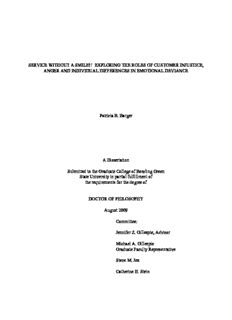
Service Without a Smile?! Exploring the Roles of Customer Injustice, Anger, and Individual PDF
Preview Service Without a Smile?! Exploring the Roles of Customer Injustice, Anger, and Individual
SERVICE WITHOUT A SMILE?! EXPLORING THE ROLES OF CUSTOMER INJUSTICE, ANGER AND INDIVIDUAL DIFFERENCES IN EMOTIONAL DEVIANCE Patricia B. Barger A Dissertation Submitted to the Graduate College of Bowling Green State University in partial fulfillment of the requirements for the degree of DOCTOR OF PHILOSOPHY August 2009 Committee: Jennifer Z. Gillespie, Advisor Michael A. Gillespie Graduate Faculty Representative Steve M. Jex Catherine H. Stein © 2009 Patricia B. Barger All Rights Reserved iii ABSTRACT Jennifer Z. Gillespie, Advisor There is a growing body of research focused on examining how customer service workers meet organizational demands to express positive emotions, a phenomenon known as emotional labor. However, it is unreasonable to assume that employees will always display appropriate emotions on the job, yet there is a dearth of research that examines the occurrence of emotional deviance (i.e., breaking display rules). The current study integrated theories from the emotional labor, justice and counterproductive work behavior literatures in order to gain an increased understanding of emotional deviance. Specifically, customer injustice and anger were examined as important predictors of emotional deviance, and the moderating roles of self-control, display rule commitment and display rule enforcement were considered. Quantitative and qualitative survey data were collected from 257 employees in various customer service jobs. The results indicated that being treated unfairly by customers was related to emotional deviance, both directly and indirectly through feelings of anger. Furthermore, employee self-control moderated the relationship between feelings of anger and emotional deviance such that those low in self-control were more likely to deviate. Although it was posited that employees low in display rule commitment would be more likely to emotionally deviate when they experience anger, a significant relationship was not found. Finally, the results supported display rule enforcement as an iv important moderator of the anger-emotional deviance relationship such that the relationship was stronger at lower levels of enforcement. Implications for research, practice and future directions are discussed. v Dedicated to my Dobe vi ACKNOWLEDGMENTS I would like to express my gratitude to my advisor, Jennifer Gillespie, whose continued guidance and advocacy have been integral to my success throughout all of my graduate school endeavors. I would also like to acknowledge my committee members, Steve Jex and Catherine Stein, for all of their helpful comments and suggestions that improved the quality of this manuscript. A big thanks also goes to my graduate faculty representative, Michael Gillespie, for his willingness to jump in at the last minute and save the day! I would like to thank my family for their constant encouragement and for sharing in the joy of having me become the “first doctor in the family!” I would also like to acknowledge the many friends at Bowling Green and elsewhere that I’ve met along the way – thanks for the support, for the commiseration, and for all of the trips to Myles! Lastly, a special thank you to JN for keeping me sane for the past five years and for believing in me from the start. It’s been a long and rewarding journey. I am very grateful for everyone who has been a part of it, no matter how big or small. Thank you all so much! vii TABLE OF CONTENTS Page CHAPTER I. INTRODUCTION .......................................................................................... 1 CHAPTER II. RELEVANT RESEARCH ............................................................................ 3 Emotional Deviance ................................................................................................... 5 Emotional Deviance as a Counterproductive Work Behavior ................................... 5 Customer Injustice ..................................................................................................... 6 Customer Injustice vs. Customer Incivility and Hostility .......................................... 8 Linking Customer Injustice with Emotional Deviance: The Role of Anger ............. 9 Overview of AET ........................................................................................... 9 AET: Customer Injustice and Anger.................................................. 9 AET: Anger and Deviance ................................................................. 10 Summary……. ........................................................................................................... 13 Individual Differences ............................................................................................... 13 Self-Control.................................................................................................... 14 Display Rule Commitment ............................................................................ 15 Individual Difference Interactions ................................................................. 17 Control Variables ....................................................................................................... 18 Model Summary......................................................................................................... 19 CHAPTER III. METHOD .................................................................................................... 21 Procedures and Participants ...................................................................................... 21 Procedure ....................................................................................................... 21 Benefits and Costs of the StudyResponse Project ............................. 21 viii Sampling ............................................................................................ 22 Participants ..................................................................................................... 23 Response Rate .................................................................................... 23 Participant Demographics .................................................................. 24 Measures……… ........................................................................................................ 26 Customer Injustice ......................................................................................... 26 Anger….......................................................................................................... 26 Emotional Deviance ....................................................................................... 27 Self-Control.................................................................................................... 28 Display Rule Commitment ............................................................................ 28 Control Variables ........................................................................................... 29 Trait Anger ......................................................................................... 29 Enforcement of Display Rules ........................................................... 29 Work Group Norms ........................................................................... 30 Positive Display Rule Perceptions ..................................................... 30 Personal Demographics ..................................................................... 30 Job Characteristics ............................................................................. 31 Free Response Questions ............................................................................... 33 Content Analysis Process ................................................................... 33 CHAPTER IV. RESULTS .................................................................................................... 36 Descriptive Statistics and Bivariate Correlations ...................................................... 36 Preliminary Analyses ................................................................................................. 37 Differences by Occupational Category .......................................................... 37 ix Display Rule Perceptions ............................................................................... 39 Hypothesis Testing..................................................................................................... 39 Post-Hoc Analyses ..................................................................................................... 45 Revised Model ........................................................................................................... 48 Open-Ended Response Results .................................................................................. 49 Emotionally Deviant Behaviors ..................................................................... 49 Reasons for Emotional Deviance ................................................................... 53 Enforcement of Display Rules ....................................................................... 55 CHAPTER V. DISCUSSION ............................................................................................... 58 The Role of Individual Differences ........................................................................... 59 Display Rule Enforcement: More than Just a Control Variable ................................ 60 No Occupational Differences in Deviance ................................................................ 62 Insights from Qualitative Data ................................................................................... 63 Practical Implications................................................................................................. 67 Limitations….. ........................................................................................................... 71 Future Directions ....................................................................................................... 73 Summary and Conclusions ........................................................................................ 76 REFERENCES……… .......................................................................................................... 77 APPENDIX A: STUDY TABLES ........................................................................................ 91 APPENDIX B: CUSTOMER INJUSTICE MEASURE ....................................................... 111 APPENDIX C: ANGER MEASURE .................................................................................... 112 APPENDIX D: EMOTIONAL DEVIANCE MEASURE .................................................... 113 APPENDIX E: SELF-CONTROL SCALE ........................................................................... 114 x APPENDIX F: DISPLAY RULE COMMITMENT SCALE ................................................ 116 APPENDIX G: TRAIT ANGER SUBSCALE ...................................................................... 117 APPENDIX H: DISPLAY RULE ENFORCEMENT SCALE ............................................. 118 APPENDIX I: OPEN-ENDED QUESTIONS ....................................................................... 119
Description: